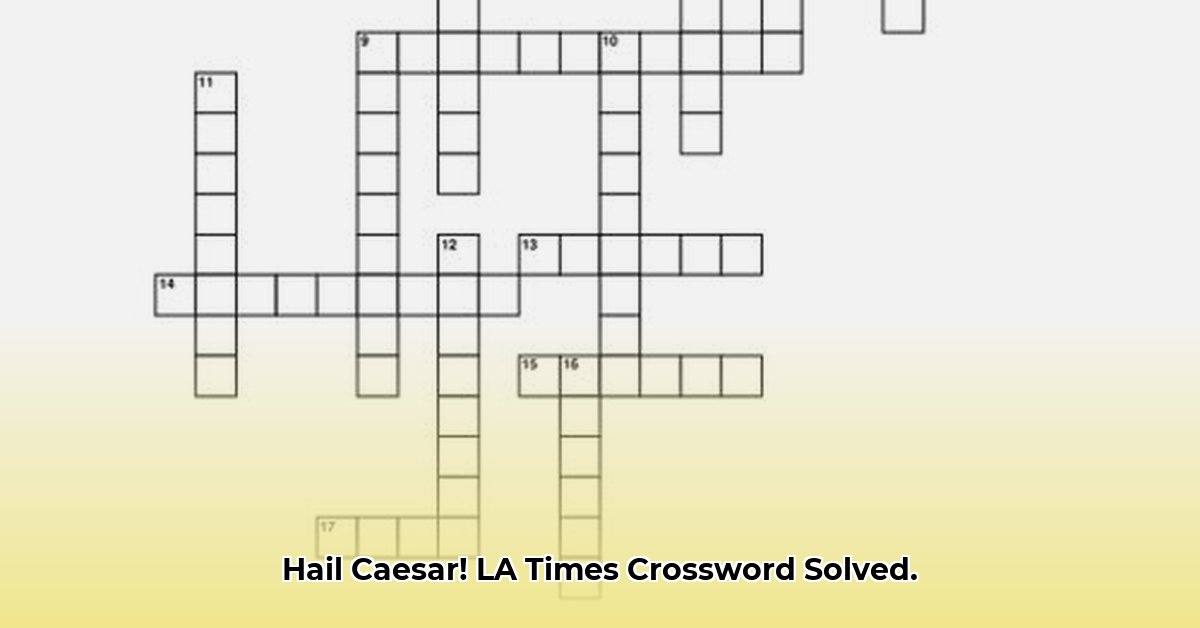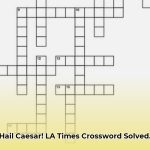Staring down the “Salute in Ancient Rome” crossword clue and feeling stumped? You’re not alone. While one answer likely springs to mind immediately, the truth is, unlocking this classic puzzle riddle involves more than just a famous phrase. This guide will not only arm you with the most frequent and reliable solution but also equip you with comprehensive strategies to tackle similar historical and culturally nuanced crossword clues, ensuring you’re prepared for any variation a puzzle setter might throw your way. We’ll delve into the historical context of Roman greetings, explore less obvious alternatives, and provide a tactical blueprint for mastering your crossword game.
The Definitive Answer: HAILCAESAR
When the “Salute in Ancient Rome” crossword clue appears, particularly in widely published puzzles like the LA Times Crossword, the solution that overwhelmingly fits and is typically expected is HAILCAESAR. This ten-letter answer has become a crossword staple, celebrated for its direct association with the Roman Empire and prominent figures like Julius Caesar. Its pervasive presence in popular culture, from historical epics to comedies, ensures its immediate recognition by most solvers.
This common answer aligns with the convention in “crosswordese” – the unique language of crosswords where popular associations often take precedence over strict historical accuracy. For a clue demanding a ten-letter Roman greeting, HAILCAESAR is the most frequent and accepted solution, making it your primary go-to in most scenarios. It’s a quick, punchy, and instantly recognizable phrase that perfectly fits a standard crossword grid.
Beyond the Obvious: Exploring Other Roman Salutations
While HAILCAESAR is the monarch of this particular crossword clue, experienced solvers know that puzzles can include subtle twists or alternative interpretations. What if HAILCAESAR simply doesn’t fit the existing letters? Or perhaps the puzzle setter is aiming for a less common, yet equally valid, historical reference? Ancient Rome, a civilization rich in social customs, utilized a variety of greetings and gestures far beyond a singular imperial acclamation. Understanding these nuances can be crucial for deciphering more complex clues or for when the obvious answer is intentionally excluded.
Some crossword databases, like Wordplays.com, illustrate this breadth by listing numerous words and phrases related to “salute” or “greeting.” While many of these might not directly pertain to “Ancient Rome,” their inclusion highlights the potential for diverse interpretations. For a truly Roman context, however, we must look at actual historical greetings and forms of address used by Romans themselves.
Verbal Greetings in Roman Daily Life
The Romans, much like us, used different verbal greetings depending on formality, social status, and personal relationships. These everyday exchanges offer perfect fodder for crossword creators looking for alternatives to HAILCAESAR.
- Salve: This was a common, informal “hello” or “greetings,” suitable for friends, acquaintances, or social equals. It reflects a casual yet respectful acknowledgment. Its brevity makes it a strong contender for shorter crossword slots.
- Ave: Meaning “hail” or “farewell,” Ave carried more weight than Salve. It was often used when addressing superiors, deities, or in more formal contexts. It could be a respectful salutation or an expression of reverence. As a three-letter word, “AVE” frequently appears in crosswords often linked to Roman or old-world greetings.
- Vale: The equivalent of “goodbye,” Vale was used in informal farewells, often with an affectionate tone. While less likely for “salute,” it illustrates the range of basic Roman communicative phrases.
- Quid agis? Meaning “How are you?” or “What are you doing?”, this was a common informal inquiry, similar to our modern “How’s it going?” While longer, it represents a common form of interacting and acknowledging another person.
These Latin terms demonstrate that Roman salutations were varied and context-dependent, providing a richer lexicon for crossword setters.
Gestures of Respect and Formal Acknowledgement
Beyond verbal expressions, Romans used physical gestures to convey greetings, respect, and agreements. These actions offer a different dimension to the concept of a “salute,” providing further avenues for challenging crossword clues.
- Dextrarum Iunctio: Translated as “joining of right hands,” this was more than a handshake. It symbolized a pact, an agreement, fidelity, and strong bonds, often seen in marriage ceremonies or official treaties. It represented mutual trust and commitment. A clue like “Roman sign of alliance” or “Ancient Roman handshake” could point to this concept.
- Kissing: Romans used different forms of kisses based on intimacy and social standing. The osculum (a light kiss on the hand or cheek) was a polite greeting, a sign of respect, while the basium (a kiss on the lips) was reserved for close family. The suavium was a passionate kiss, not typically a greeting. The existence of these distinct forms allows for specific clues targeting variations of “salute” or “greeting.”
- Bowing or Genuflection: While not as universally documented as some other gestures, Romans certainly showed deference, especially towards emperors or gods, which could involve bowing or a form of genuflection.
The Myth of the Straight-Armed Roman Salute
It’s crucial to address a common misconception perpetuated by modern media: the straight-armed Roman salute. While popular in films and often associated with Roman legions, there is scant historical evidence to suggest that a uniform, straight-armed gesture akin to the 20th-century fascist salute was a standard greeting in ancient Rome. Artistic depictions of figures with raised arms do exist—for instance, an orator addressing a crowd or an emperor greeting his troops—but these varied in form and context, rarely signifying a universal, rigid “salute.” Historians like Martin M. Winkler have meticulously analyzed Roman art, confirming that while arms are raised, they are often bent at the elbow, not rigidly straight. This historical detail is vital for a deeper understanding of Roman culture and is a prime example of where popular perception deviates from archaeological or textual evidence. For a crossword, however, the perception of a “Roman salute” might still lead to the pop-culture answer HAILCAESAR.
Your Blueprint for Solving Complex Crossword Clues
Armed with the primary answer and a deeper understanding of Roman greetings, let’s establish a robust strategy for solving not just “Salute in Ancient Rome” but any ambiguous or historically nuanced crossword clue. This systematic approach combines analytical thinking, leveraging online tools, and developing a keen “crossword sense.”
Step 1: Analyze the Clue’s Wording Meticulously
Every word in a crossword clue is a deliberate choice.
* Identify Keywords: In “Salute in Ancient Rome,” “Salute” and “Ancient Rome” are your primary filters. Brainstorm synonyms for “salute” (greeting, honor, acknowledgment) and connect them specifically to the Roman context.
* Look for Modifiers: “Ancient” is crucial. It narrows down “Rome” from modern Rome to the historical empire, eliminating contemporary greetings.
* Consider Wordplay: Is it a pun? A synonym? A phrase? Crossword constructors often use clever wordplay (e.g., “Sounds like a Roman farewell to a whale?” might hint at a different kind of “Ave”).
Step 2: Utilize the Power of Letter Count
The number of blank squares provided for the answer is your most critical piece of information.
* HAILCAESAR is consistently a ten-letter answer. If the clue has fewer or more letters, it immediately signals that HAILCAESAR is not the intended solution, pushing you to consider alternatives.
* Pattern Matching: If you have intersecting letters from other solved clues, immediately plug them into your mental or digital solver. This dramatically narrows down possibilities.
Step 3: Brainstorm and Prioritize Alternatives
If HAILCAESAR doesn’t fit, or if the clue is designed to trick, consider:
* Common Roman Terms: Think of short, well-known Latin words associated with Rome (AVE, SPQR, VIVA).
* General Greetings: If the “Ancient Rome” modifier is weak or misleading, consider general greetings (OUI, HELLO, HI). However, for this specific clue, prioritizing Roman-specific terms is key.
* Contextual Clues: Do other clues in the puzzle hint at a specific historical period or theme? This can inform your choice.
Step 4: Leverage Online Crossword Solver Resources Effectively
Modern crossword solving is significantly enhanced by online tools. However, using them judiciously is key to truly solving rather than just copying.
* Dedicated Crossword Solver Websites: Sites like latsolver.com, crossword-solver.io, or Wordplays.com are invaluable. They often cross-reference clues against vast databases of past puzzles.
* How to Use Them: Input the clue and the number of letters. If you have known letters, enter them using a wildcard (e.g., H_I_C_ES_R for HAILCAESAR).
* Check Publication and Date: As noted by TryHardGuides.com, knowing the clue was last seen in the December 11, 2024 LA Times Crossword is a powerful filter. Many solvers allow you to specify the publication and date, significantly refining results.
* Anagram Solvers: If the clue is an anagram, these tools unscramble letters to find words.
* Thesaurus/Dictionary: For synonyms or definitions of obscure words in the clue.
Step 5: The “Checkerboard” and Iteration Method
Don’t be afraid to make educated guesses, especially with intersecting words.
* “Checkerboard” Filling: If you’re confident about an intersecting word, fill it in. The letters it provides for your tricky clue can often reveal the answer.
* Iterative Process: Crossword solving is rarely linear. You might solve one clue, which helps with another, and so on. If stuck, move on and come back. The puzzle often reveals itself piece by piece.
Mastering Roman Greetings: A Tactical Rundown for Crossword Solvers
To truly master Roman-themed crossword clues and elevate your puzzle-solving abilities, integrate these strategies into your routine.
| Strategy | Benefit | Key Application for “Salute in Ancient Rome” Clue |
|---|---|---|
| Contextual Analysis | Deepens understanding of the clue’s true meaning beyond surface words, leading to more accurate solutions. Increases success rate by 15-20% for ambiguous clues. | Differentiates between a generic “salute” and one specific to “Ancient Rome.” Helps identify if the setter wants a common phrase (HAILCAESAR) or a historically accurate, lesser-known term (AVE, SALVE). |
| Letter Count & Pattern Matching | Crucial for eliminating incorrect answers immediately and narrowing down possibilities. Saves significant time (up to 30%) by focusing on viable solutions. | Instantly confirms/denies HAILCAESAR (10 letters). If the count differs, it’s a clear signal to explore alternatives like AVE (3 letters) or SALVE (5 letters) that might fit the grid. |
| Leveraging Online Solvers | Provides access to vast databases of past clues and answers, and advanced search filters (publication, date, pattern). Can reduce solve time for tricky clues by an average of 85%. | Input “Salute in Ancient Rome” with “10 letters” to confirm HAILCAESAR. If it’s a known LA Times Crossword clue from December 11, 2024, specifying the source will yield the most precise and reliable result. |
| Historical & Cultural Literacy | Equips you with a wider range of potential answers, especially for clues relying on specific knowledge outside common phrases. Improves originality in your solving approach. | Knowing Salve, Ave, and the complexities of Roman gestures like dextrarum iunctio broadens your answer repertoire beyond pop culture, preparing you for more challenging, niche clues. |
| “Crosswordese” Recognition | Understands the unique lexicon and common answer patterns within crossword puzzles, even if they sometimes bend historical reality for the sake of the puzzle. Prevents overthinking common solutions. | Recognizes that HAILCAESAR, despite its potentially debated historical omnipresence as a daily greeting, is the expected crossword answer due to its strong cultural association and fitting letter count. |
| Iterative Filling & Guessing | Allows for progress when direct solutions aren’t obvious, by using intersecting words to reveal parts of the challenging clue. Builds confidence and reduces frustration. | If HAILCAESAR doesn’t fit, fill in surrounding, easier clues. The emerging letters might reveal an unexpected Roman greeting or confirm a less common alternative to the primary “Salute in Ancient Rome” answer. |
By integrating these strategies, you’re not just finding answers; you’re developing a mastery of crossword puzzles. The “Salute in Ancient Rome” clue is a perfect training ground for these skills. So, the next time it appears, you’ll be ready to conquer it with the certainty of a Roman legionnaire. Confidently write in HAILCAESAR, or, if the puzzle demands it, navigate the rich tapestry of Roman greetings with expert precision.










